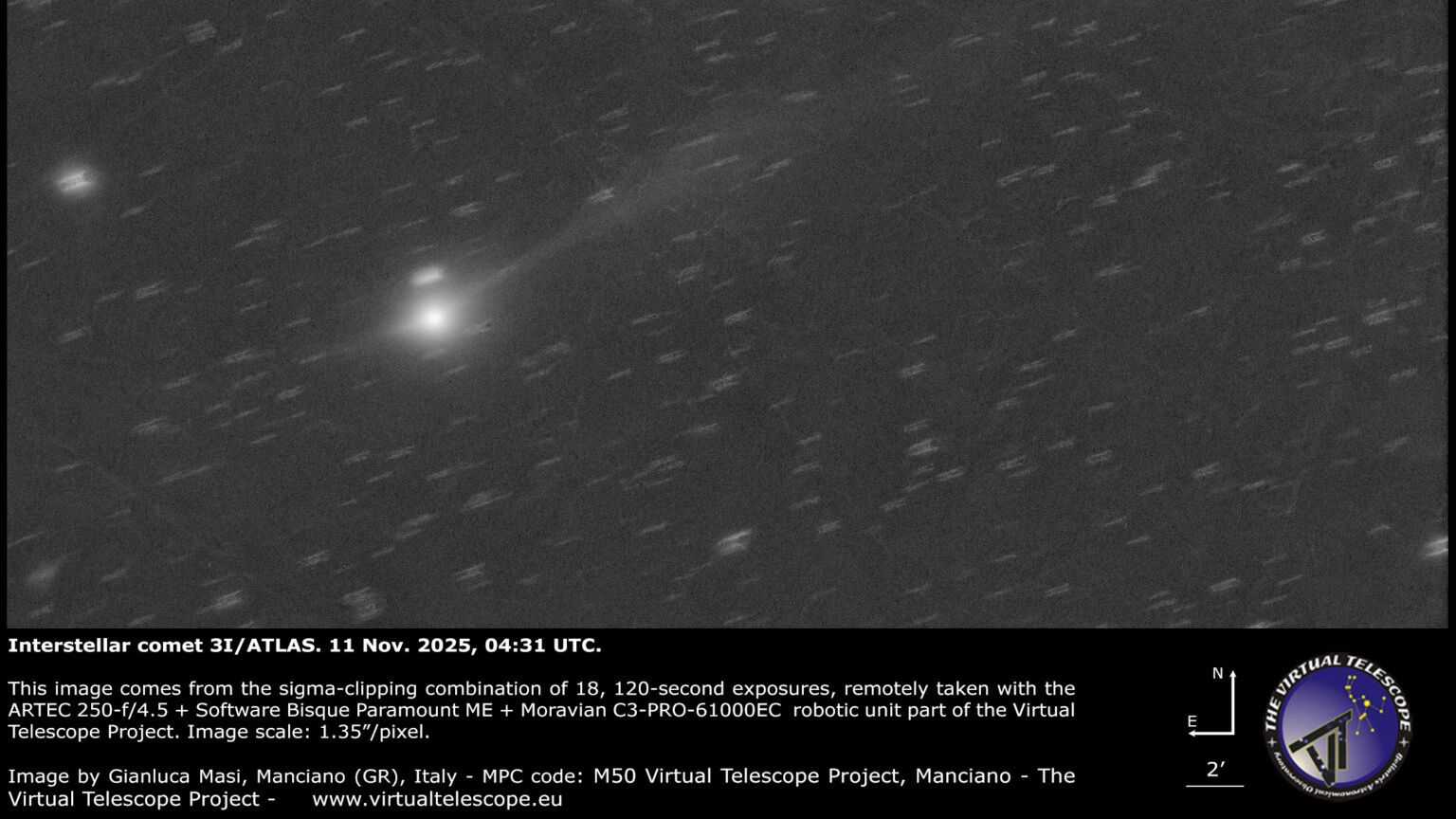☄️ 3I/ATLAS: the spectacular plumes of the interstellar object
Follow us on Google News (click on ☆)
The recent image from the Virtual Telescope project reveals a remarkable transformation of comet 3I/ATLAS. Captured from Italy using robotic telescopes, this photograph combines eighteen exposures of two minutes each. Despite difficult observing conditions with the Moon illuminating the sky, the ion tail appears with exceptional clarity. Gianluca Masi, the project founder, indicates in a publication the constant improvement of this gaseous structure.

The interstellar comet 3I/ATLAS photographed on November 10, showing a bright nucleus and a well-defined ion tail
Credit: The Virtual Telescope Project
The formation of this tail results from a precise physical process. Solar ultraviolet radiation strips electrons from the gaseous molecules ejected by the comet, thus creating charged ions. These particles are then carried away by the solar wind, that constant stream of ionized matter coming from our star. Unlike the dust tail that follows the orbital trajectory, the ion tail always points directly away from the Sun, regardless of the direction of the comet's motion.
Detailed analysis of the image shows a bright nucleus surrounded by a compact coma, while the ion tail extends for about 0.7 degrees in the sky. A faint anti-tail is also visible, an optical phenomenon due to Earth's perspective that makes dust appear to stretch in the opposite direction. This increase in activity compared to previous observations indicates a more intense release of gas and dust under the effect of solar heating.
The third confirmed interstellar object after 1I/'Oumuamua and 2I/Borisov, 3I/ATLAS has an essential particularity: its brightness allows for in-depth study from Earth. Astronomers thus benefit from a unique opportunity to observe how a comet originating from another stellar system reacts to the influence of our Sun. This exceptional situation opens new perspectives for understanding interstellar objects.
The elongation and strengthening of the tail indicate increased sublimation of volatile materials, probably including carbon dioxide and dust. These elements are then expelled into space under the pressure of the solar wind. Preliminary data show a high proportion of carbon dioxide ice, which could reveal information about the conditions of the distant planetary system where this comet formed.
The Virtual Telescope project continues its observation program of 3I/ATLAS during its passage through the inner Solar System. Professional and amateur astronomers can follow the evolution of this cosmic visitor thanks to images regularly published since its initial detection last July. This continuous monitoring will document the comet's transformations during its solar journey.
The formation of cometary tails
Comets generally develop two distinct types of tails during their approach to the Sun. The dust tail, composed of solid particles, follows the object's orbital trajectory and often appears yellowish in color. The dust grains released by the nucleus reflect sunlight, creating this characteristic trail that curves slightly.
The ion tail, on the other hand, forms through a different mechanism. The Sun's ultraviolet radiation ionizes the gases in the coma, stripping electrons from atoms and molecules. These electrically charged ions then become sensitive to the magnetic field carried by the solar wind. They are accelerated and aligned in the direction opposite to our star.
This plasma tail often shows a bluish tint due to specific emissions from ionized molecules, particularly carbon monoxide. Its structure generally appears more rectilinear and dynamic than the dust tail, and can show discontinuities and sudden accelerations. Simultaneous observations of both tails provide complementary information about the composition and activity of the cometary nucleus.
Comparative study of cometary tails allows scientists to determine the nature of volatile materials and their sublimation rate. Each type of tail reacts differently to variations in solar activity, thus offering a dual indicator of the physical processes at play during comets' passage near the Sun.
Interstellar objects in our Solar System
The detection of interstellar objects is going through a particularly active phase in recent years. Before 2017, their existence remained theoretical, but the successive observations of 1I/'Oumuamua, 2I/Borisov and now 3I/ATLAS have confirmed that our Solar System regularly receives visits from celestial bodies originating in other stellar systems. These cosmic travelers reach us after wandering in interstellar space for millions of years.
Each interstellar object studied so far presents unique characteristics:
- 1I/'Oumuamua showed an unusual elongated shape and an intriguing non-gravitational acceleration.
- 2I/Borisov more closely resembled Solar System comets, with notable activity.
- 3I/ATLAS combines sufficient brightness for detailed observations and increasing activity that allows studying its evolution in real time.
Analysis of these external visitors offers unprecedented perspectives on the formation of planetary systems. Their composition reflects the conditions that prevailed in their system of origin, potentially very different from those of the protosolar cloud. The relative proportions of ices and dust, as well as their internal structure, constitute as many clues about planetary formation processes elsewhere in the Galaxy.
The detection frequency of these objects indicates they could be much more numerous than previously thought. New astronomical instruments, like the future Vera Rubin Observatory, should significantly increase the discovery rate. This growing population of interstellar objects will allow establishing statistics about their nature and origin, broadening our understanding of the diversity of planetary systems.